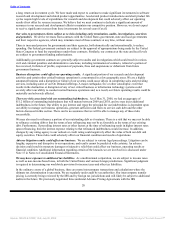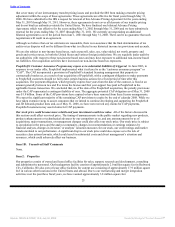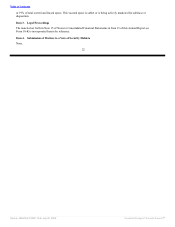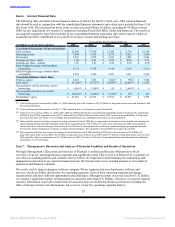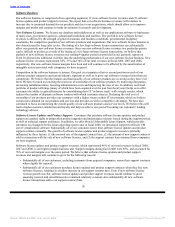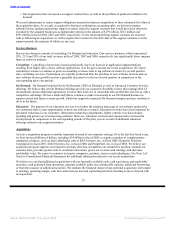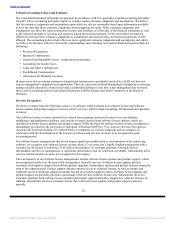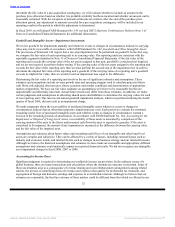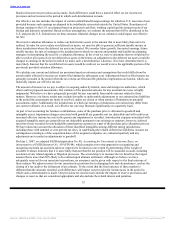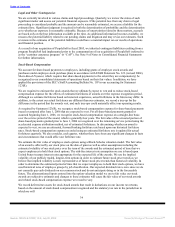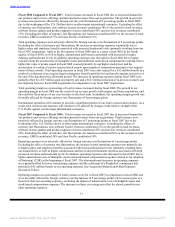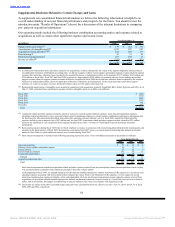Oracle 2007 Annual Report Download - page 33
Download and view the complete annual report
Please find page 33 of the 2007 Oracle annual report below. You can navigate through the pages in the report by either clicking on the pages listed below, or by using the keyword search tool below to find specific information within the annual report.
Table of Contents
Critical Accounting Policies and Estimates
Our consolidated financial statements are prepared in accordance with U.S. generally accepted accounting principles
(GAAP). These accounting principles require us to make certain estimates, judgments and assumptions. We believe
that the estimates, judgments and assumptions upon which we rely are reasonable based upon information available
to us at the time that these estimates, judgments and assumptions are made. These estimates, judgments and
assumptions can affect the reported amounts of assets and liabilities as of the date of the financial statements as well
as the reported amounts of revenues and expenses during the periods presented. To the extent there are material
differences between these estimates, judgments or assumptions and actual results, our financial statements will be
affected. The accounting policies that reflect our more significant estimates, judgments and assumptions and which
we believe are the most critical to aid in fully understanding and evaluating our reported financial results include the
following:
• Revenue Recognition
• Business Combinations
• Goodwill and Intangible Assets—Impairment Assessments
• Accounting for Income Taxes
• Legal and Other Contingencies
• Stock-Based Compensation
• Allowances for Doubtful Accounts
In many cases, the accounting treatment of a particular transaction is specifically dictated by GAAP and does not
require management’s judgment in its application. There are also areas in which management’s judgment in selecting
among available alternatives would not produce a materially different result. Our senior management has reviewed
these critical accounting policies and related disclosures with the Finance and Audit Committee of the Board of
Directors.
Revenue Recognition
We derive revenues from the following sources: (1) software, which includes new software license and software
license updates and product support revenues, and (2) services, which include consulting, On Demand and education
revenues.
New software license revenues represent fees earned from granting customers licenses to use our database,
middleware and applications software, and exclude revenues derived from software license updates, which are
included in software license updates and product support. While the basis for software license revenue recognition is
substantially governed by the provisions of Statement of Position (SOP) No. 97-2, Software Revenue Recognition,
issued by the American Institute of Certified Public Accountants, we exercise judgment and use estimates in
connection with the determination of the amount of software and services revenues to be recognized in each
accounting period.
For software license arrangements that do not require significant modification or customization of the underlying
software, we recognize new software license revenue when: (1) we enter into a legally binding arrangement with a
customer for the license of software; (2) we deliver the products; (3) customer payment is deemed fixed or
determinable and free of contingencies or significant uncertainties; and (4) collection is probable. Substantially all of
our new software license revenues are recognized in this manner.
The vast majority of our software license arrangements include software license updates and product support, which
are recognized ratably over the term of the arrangement, typically one year. Software license updates provide
customers with rights to unspecified software product upgrades, maintenance releases and patches released during the
term of the support period. Product support includes internet access to technical content, as well as internet and
telephone access to technical support personnel located in our global support centers. Software license updates and
product support are generally priced as a percentage of the net new software license fees. Substantially all of our
customers purchase both software license updates and product support when they acquire new software licenses. In
addition, substantially all of our customers renew their software license updates and product support contracts
annually.
28
Source: ORACLE CORP, 10-K, July 02, 2008 Powered by Morningstar® Document Research℠




